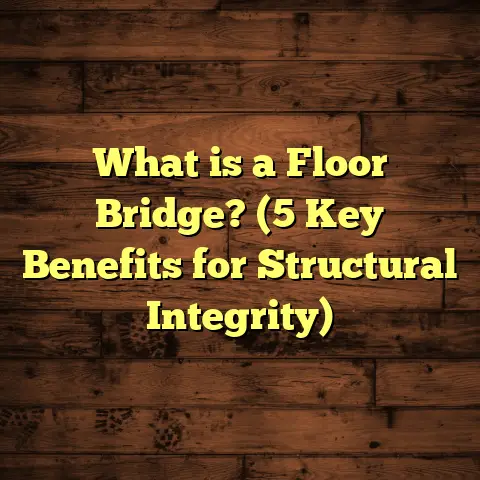What is Terrazzo Flooring Cost? (5 Factors You Must Know)
Transforming a dull, cracked floor into a stunning, durable surface can feel like a huge win, right? I remember the first time I worked with terrazzo flooring—it was a game changer for one of my clients who wanted something timeless yet modern. Seeing that floor come to life was not just satisfying; it taught me a lot about what goes into terrazzo flooring cost and why it’s worth every penny in many cases. If you’ve ever wondered, what is terrazzo flooring cost? and what factors influence it, stick around. I’ll share my experiences, some data, and tips to help you understand this unique flooring option better.
What Is Terrazzo Flooring?
Terrazzo flooring is a composite material made by embedding small chips of marble, quartz, granite, glass, or other materials into a cement or epoxy binder. Once the mixture cures, it’s polished to reveal a smooth, shiny surface that’s both beautiful and durable. The key here is the mixture of aggregates and binders that make terrazzo both an art and a science.
This flooring style dates back hundreds of years but has been reimagined in modern times with new materials and techniques. Unlike traditional tiles or hardwood, terrazzo creates a continuous surface without grout lines, which makes it super easy to clean and maintain.
I love this flooring because it combines aesthetics with function. However, the process to install terrazzo is quite labor-intensive and requires skilled craftsmanship. This is one reason why many people ask me about the cost involved before deciding if it’s right for their project.
When I explain terrazzo to clients for the first time, I often start by telling them it’s like creating a giant piece of mosaic art underfoot. Unlike individual tiles, terrazzo blends many colors and textures in one seamless surface. It’s an ancient technique that has evolved but still requires attention to detail, from mixing materials correctly to grinding and polishing to perfection.
Successes and Challenges in Working with Terrazzo
In my years working with terrazzo floors, I’ve seen some incredible transformations. One memorable project was a commercial lobby where we replaced outdated carpeting with terrazzo. The end result? A floor that gleamed under soft lighting and held up beautifully to heavy foot traffic. My client was thrilled because the floor not only looked great but also reduced maintenance costs over time.
What I found interesting was how often this flooring surprises new clients with its durability. One lady told me she was initially worried about scratches or chips because she has three kids and two dogs. Years later, she said the terrazzo had held up better than any floor she’d ever owned.
That said, it’s not all smooth sailing. The biggest challenge I’ve faced is timing and budgeting. Terrazzo installation isn’t quick; depending on the project size, it can take several weeks due to curing times and polishing stages. For homeowners on a tight schedule, this can be frustrating.
Another issue is cost predictability. Terrazzo pricing varies widely based on materials, design complexity, and labor rates. In one residential job, unexpected substrate repairs added to the bill significantly. Learning from that experience, I now recommend always factoring in a buffer for surprises.
Sometimes clients underestimate how much prep work the floor underneath might need. Concrete slabs might have cracks or moisture issues that need fixing before terrazzo goes down. If you don’t catch these early, it can delay the project by days or even weeks.
On another job, I had a client who wanted a really complex terrazzo design with multiple colors and embedded logos for their office lobby. It was beautiful but cost more than their original budget because of the extra time and materials needed for precision work.
Despite these challenges, terrazzo remains one of my favorite floor types because when done well, it’s practically timeless — it looks amazing and lasts forever.
Breaking Down Terrazzo Flooring Cost: 5 Crucial Factors
Let me walk you through the five main factors that affect terrazzo flooring cost based on my experience:
1. Material Type and Quality
The choice of aggregates—marble chips versus glass or quartz—plays a huge role in cost. Marble chips tend to be less expensive but give that classic look most people want. On the other hand, glass or quartz chips add color variety and sparkle but come at a premium.
For example, I once estimated a project using recycled glass terrazzo for about $20 per square foot, while marble chip terrazzo hovered around $15-$18 per square foot. Epoxy-based terrazzo costs more upfront than cement-based but offers better stain resistance and faster installation.
Let me break this down more deeply:
- Marble Chips: These are the most traditional choice for terrazzo floors. Marble is abundant and relatively affordable compared to other aggregates. It gives floors a natural stone look with subtle variation in color. Cost-wise, marble chips are usually the baseline for estimating prices.
- Glass Chips: These provide vibrant colors because glass can be tinted in countless shades. I worked on a project where we used recycled glass chips in blues and greens to create an ocean-themed floor in a coastal hotel lobby. They were stunning but raised costs by 10-20% over marble chips because of sourcing and handling requirements.
- Quartz or Granite: These offer tougher surfaces with unique textures but can be pricier due to natural stone scarcity or processing difficulty.
The binder type also matters:
- Cement-based Terrazzo: This is the more traditional option and usually costs less but takes longer to cure (sometimes weeks). The surface is matte unless polished extensively.
- Epoxy-based Terrazzo: This newer binder cures faster (days instead of weeks), offers brighter colors because epoxy is clear, and provides superior stain resistance. The downside is sensitivity to UV light (it can yellow over time) and higher material costs.
2. Installation Complexity
Terrazzo isn’t just poured like concrete; it requires careful layering, grinding, and polishing. Intricate designs or custom color patterns can add labor hours—and dollars—to the final price.
I had one client who wanted an elaborate geometric pattern with multiple colors. The labor cost alone increased by nearly 25% compared to a simple solid color terrazzo floor.
Let me give you an idea of what complexity means in practice:
- Simple Floors: Just one color mix spread evenly throughout the area with no patterns or borders.
- Moderate Complexity: Two or three colors combined with simple borders or shapes.
- High Complexity: Multiple colors with detailed logos, graphics, or unusual shapes embedded in the floor.
Every extra color or design element means more time spent setting up divider strips (to separate colors during pouring), mixing different batches of terrazzo mix accurately, grinding carefully at edges to avoid blending colors unintentionally, and polishing each section evenly.
From my experience managing projects with varied complexity levels:
- Simple floors usually take 4-6 days to complete for an average room.
- Complex floors can take 2-3 weeks or longer depending on size.
That’s why complexity can increase labor costs substantially—sometimes doubling them compared to basic installations.
3. Project Size
This might sound obvious, but larger areas often bring down the price per square foot because of economies of scale. Small patches or repair jobs tend to be more expensive per square foot due to setup time and material wastage.
For instance, in a small powder room remodel (about 50 sq ft), I quoted around $35 per square foot. But in a large office space (3000 sq ft), costs dropped closer to $18-$20 per square foot.
The logic behind this is simple: when working on very small jobs, fixed costs like site setup (cleaning space, bringing equipment), mixing materials in small batches (which is less efficient), and travel time don’t scale down proportionally to size.
Also, bigger projects allow contractors like me to order materials in bulk at discounted prices and maintain steady workflow without frequent interruptions for setup or teardown.
One interesting case was a high school gymnasium floor we refurbished with terrazzo covering nearly 5,000 square feet. Because of the massive size, we negotiated great deals on materials which brought down costs significantly compared to smaller commercial jobs I’d done before.
4. Substrate Condition
The condition of the existing floor foundation can affect costs dramatically. Uneven or damaged concrete slabs need prep work before terrazzo installation can begin.
On one job, I had to repair cracks and level the floor before installing terrazzo. This prep added almost 15% extra to the total cost but was necessary for a flawless finish.
Substrate issues I’ve encountered include:
- Cracks from settling or moisture damage
- Uneven surfaces requiring grinding or new leveling compounds
- Old adhesives or coatings needing removal
- Moisture vapor barriers required in some cases
If these problems aren’t addressed properly before laying terrazzo, the floor can crack later or show imperfections after polishing—leading to costly repairs down the line.
In my experience, budgeting for substrate prep upfront saves headaches later. I recommend scheduling a thorough inspection early in planning so you know what you’re dealing with before committing financially.
5. Geographic Location and Labor Rates
Labor costs vary by region and installer expertise. Urban areas with high living costs tend to have pricier labor rates than rural zones.
I use tools like FloorTally to keep up with local labor market rates—it helps me estimate realistic bids quickly without wasting time chasing numbers manually.
From what I’ve seen comparing jobs in different states:
- In major metro areas like New York City or San Francisco, labor rates can be 30-50% higher than in smaller towns.
- Skilled terrazzo installers are less common everywhere; when demand outstrips supply (such as during construction booms), prices spike.
- Some regions have unions that set wages which affect overall costs too.
FloorTally helps me track these variations efficiently by providing up-to-date labor cost benchmarks based on location inputs. That way, I can strike a balance between competitive pricing for clients and fair compensation for workers.
Real Numbers: What Does Terrazzo Flooring Cost?
Based on various projects I’ve handled over the last five years, here are some ballpark figures:
| Project Type | Cost per Sq Ft (USD) | Notes |
|---|---|---|
| Residential (small) | $30 – $40 | Includes simple designs |
| Commercial (large) | $18 – $25 | Bulk pricing on materials |
| Custom Designs | $35 – $50 | Increased labor & complexity |
| Epoxy Terrazzo | $25 – $45 | Faster installation |
| Cement Terrazzo | $15 – $30 | Longer cure time |
These costs include materials, labor, polishing, and sealing but exclude substrate repair or removal.
To give you some context: When I quoted a mid-sized bathroom remodel at about $40/sq ft using epoxy terrazzo with custom colors in 2023, it included everything from substrate prep to final polishing plus sealant application. The client was happy because they got something truly unique that would last decades.
On bigger projects like office lobbies or schools where we used simpler designs with cement-based terrazzo floors covering thousands of square feet, prices came down closer to $18-$22 per sq ft due to volume discounts and simpler patterns.
It helps to think about how long you want your floor to last versus upfront investment: terrazzo floors typically outlive carpet or laminate floors by decades if maintained properly—making them excellent long-term value even if initial costs seem high.
How I Use FloorTally for Estimating Terrazzo Costs
When I plan a terrazzo project, getting accurate cost estimates upfront is crucial for avoiding surprises later on. FloorTally has become my go-to tool for this because it pulls local material prices and labor rates into one place. It’s not just about numbers; the tool lets me tweak variables like waste factor or design complexity so my estimates stay realistic.
I remember working on a mid-sized office renovation where I used FloorTally to compare epoxy versus cement terrazzo options quickly. This helped me discuss pros and cons with the client transparently and decide on epoxy because of its faster turnaround despite slightly higher upfront cost.
Here’s what makes FloorTally handy:
- Local Pricing Accuracy: It uses real-time data about material availability and labor wages based on your location.
- Waste Factor Inclusion: Terrazzo tends to have some extra material waste during mixing/pouring; FloorTally factors this into estimates.
- Customization Options: You can input design complexity levels which adjust labor hours.
- Time Savings: Instead of calling multiple suppliers or contractors for quotes manually—which can take days—I get instant estimates that are quite reliable.
- Budget Management: Helps me set realistic budgets clients can trust so there’s less back-and-forth once work begins.
I’m not saying you should rely solely on any tool without onsite inspection or expert advice—but having something like FloorTally streamlines early planning enormously.
Why Choose Terrazzo Despite Its Cost?
You might wonder if terrazzo’s higher price tag is justified compared to cheaper options like vinyl or laminate floors. Here’s why I think it’s often worth it:
- Longevity: Terrazzo floors can last decades—sometimes over 75 years—with proper care.
- Low Maintenance: Unlike wood or carpet, terrazzo doesn’t trap dirt or require frequent refinishing.
- Aesthetic Flexibility: You can customize colors and patterns extensively.
- Eco-Friendly Options: Many terrazzo mixes use recycled glass or marble chips.
- Increased Property Value: A well-installed terrazzo floor can boost resale value due to its luxury appeal.
One client told me she felt she finally had “a floor that grows old gracefully” after switching from wood to terrazzo in her kitchen renovation. She loved how spills wiped right off without staining compared to previous hardwood floors which needed refinishing every few years.
Another success story came from a boutique hotel renovation where we used bold colored glass chip terrazzo floors in public areas — the look was memorable enough that guests posted photos online regularly. That kind of aesthetic impact is hard to match with cheaper flooring options.
Personal Story: The Most Challenging Terrazzo Project I Handled
One time, I took on a historic building restoration that involved matching original terrazzo patterns from nearly 80 years ago. The challenge was immense because original materials were no longer available, so we had to source similar aggregates and create custom binders while preserving the building’s character.
The project took longer than expected—almost double the usual timeline—and costs climbed due to specialized labor and materials sourcing. But when it was finished, the floor looked authentic and stunning. It reminded me why patience and skill matter so much in terrazzo work.
This job included:
- Careful removal of old damaged terrazzo sections without harming surrounding areas
- Lab testing old samples to replicate colors accurately
- Hand-cutting divider strips for intricate borders
- Multiple rounds of polishing using different grit levels
Despite headaches along the way (including supply delays), seeing that shiny vintage floor restored perfectly made it all worthwhile both for me professionally and for my client emotionally connected to their heritage space.
Common Questions People Ask Me About Terrazzo Cost
Q: Can I install terrazzo myself?
Most DIYers find terrazzo hard because it requires specialized grinding and polishing equipment plus knowledge of mixing binders correctly.
Q: How long does terrazzo installation take?
Typically 2-4 weeks for average residential spaces including curing and polishing stages.
Q: Is epoxy or cement-based terrazzo better?
Epoxy is quicker to install and stain-resistant but costs more; cement-based is traditional but takes longer to cure.
Q: How do I maintain terrazzo floors?
Regular cleaning with neutral pH cleaners works best; periodic resealing every few years keeps floors looking fresh.
Q: Is terrazzo slippery?
When polished highly smooth, yes it can be slippery when wet—adding anti-slip treatments helps in commercial areas.
Q: Can terrazzo crack?
Yes if substrate shifts or isn’t prepared well; proper substrate inspection reduces risk significantly.
Tips From My Experience: Getting the Best Value Out of Your Terrazzo Investment
If you’re seriously thinking about installing terrazzo flooring:
- Plan ahead: Don’t rush scheduling; account for curing times.
- Inspect substrate early: Budget extra if repairs needed.
- Choose simpler designs if budget tight: Solid colors save money.
- Ask installers about their experience: Terrazzo requires skill.
- Consider epoxy for kitchens/bathrooms: Better stain resistance.
- Use tools like FloorTally: Helps keep budget realistic.
I’ve learned that clear communication with clients about these points reduces stress later on because everyone knows what they’re paying for and why timelines stretch sometimes.
Final Thoughts on Terrazzo Flooring Cost
Deciding on terrazzo flooring means balancing beauty with budget and timeline realities. From my experience, understanding those five key factors—materials, installation complexity, project size, substrate condition, and local labor costs—helps prevent surprises later on.
If you plan carefully and use tools like FloorTally for budgeting help, you can enjoy stunning floors that stand the test of time without breaking the bank unexpectedly.
Have you ever seen or worked with terrazzo floors? What questions do you have about pricing or installation? Let me know—I’m here to help you get your flooring right!





